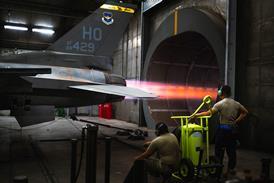Stewart Penney/LONDON
A group of European nations is poised to begin development of a common targeting pod to replace the host of systems currently in service.
France, Italy, Spain and the UK were due to sign a statement of intent to develop a next generation electro-optical, day/night targeting pod as Flight International went to press. Germany may join later.
A technology demonstrator is to be produced as a result of work already completed on the UK-French Joint Airborne Navigation and Attack (JOANNA) system.
David Lascelles, sensor, avionics and navigation systems integrated project team leader at the UK Defence Procurement Agency (DPA), says a JOANNA contract is soon to be signed with a BAE Systems/Thales team.
JOANNA is a risk-reduction exercise developing technology for a fourth-generation pod known as ASTRID (Airborne System for Target Recognition, Identification and Designation). Work on the new pod will be expanded to include Italy and Spain.
ASTRID will be designed to provide improved platform survivability by allowing greater stand-off ranges and will be better suited to today's operational environment, which has strict rules of engagement and demands for zero collateral damage.
Because of the increased number of single-seat fighters entering service, ASTRID will have greater automation, including target recognition and non co-operative target identification using laser illumination techniques. As with JOANNA, the UK will be ASTRID programme leader.
Lascelles hopes the statement of intent covering ASTRID and the related Four Nation JOANNA technology demonstrator will become a firm memorandum of understanding by the end of this year.
Meanwhile, the UK is negotiating to upgrade its BAE Systems TIALD targeting pods to incorporate lessons from Operation Allied Force against Yugoslavia in 1999.
Lascelles says the resulting TIALD 500 will have a second generation thermal imager to improve stand-off ranges, target identification and recognition and to allow some battle damage assessment.
The upgrade will also have an inertial measurement unit within the pod to counter some of the latency problems caused by the transfer of navigation data from aircraft systems to the pod.
Source: Flight International























